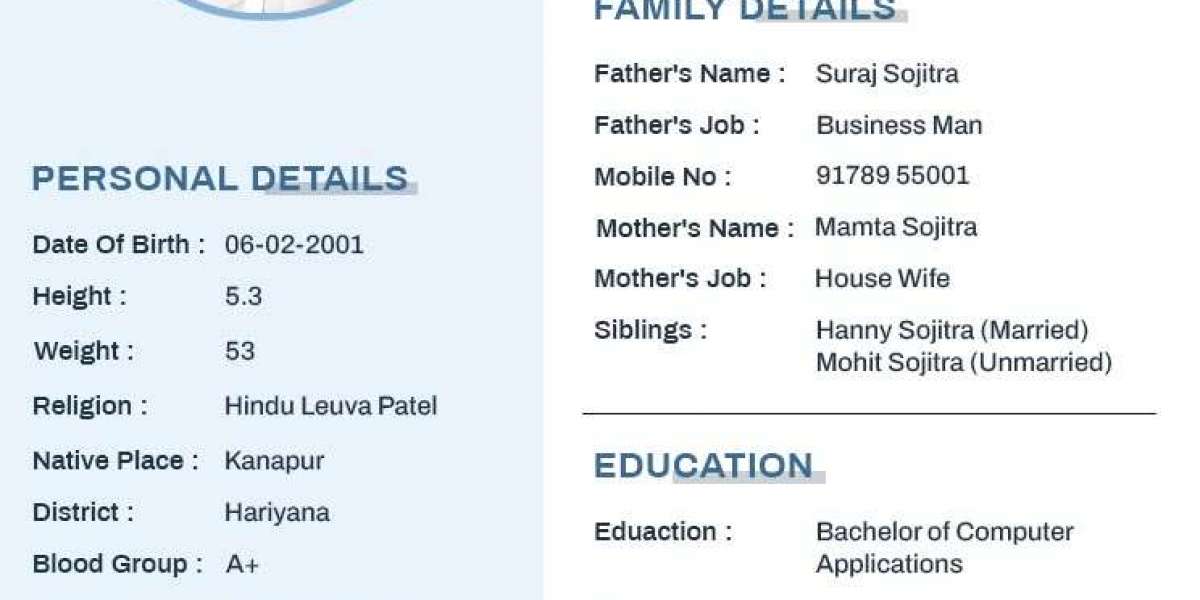What is a Biodata for Marriage?
In many cultures, especially in South Asia, a biodata for marriage is a key document used in arranged marriages. It’s essentially a matrimonial resume that provides important details about a person, including their family background, education, profession, and personal preferences. The purpose of a biodata for marriage is to give prospective partners and their families a well-rounded understanding of an individual's background, values, and life goals.
A well-structured biodata for marriage can play a crucial role in finding a compatible match. This article will guide you through everything you need to know about creating an effective biodata for marriage, including its components, importance, and tips for making a lasting impression.
Why is a Biodata for Marriage Important?
In an arranged marriage setup, the biodata for marriage is often the first step in the process of finding a potential life partner. It helps families and individuals assess compatibility based on the information provided. This document is important for the following reasons:
First Impressions Matter: The biodata acts as an introduction and can influence whether or not a prospective match wants to pursue further discussions.
Saves Time: A well-structured biodata for marriage helps both parties quickly understand if they share common values and interests, thus streamlining the process.
Reflects Personality and Background: It provides insights into your personality, family values, educational background, and career, all of which are critical in determining compatibility.
Establishes Expectations: By clearly outlining personal details and preferences, a biodata sets the stage for future conversations and avoids misunderstandings.
Key Components of a Biodata for Marriage
To make your biodata for marriage effective and appealing, it should include several key sections. These sections are designed to provide a comprehensive yet concise overview of the individual.
1. Personal Details
This section is the core of any biodata for marriage. It provides essential information about the individual such as:
- Name: Include your full name.
- Date of Birth: Age is often a key factor in arranged marriages, so mention it clearly.
- Place of Birth: This adds context to your background.
- Height and Weight: Physical attributes may play a role in preferences.
- Religion and Caste: In many traditional cultures, these are vital aspects of compatibility.
- Languages Known: Mention all the languages you are fluent in.
- Contact Information: Provide either your own or a family member’s contact details.
2. Educational Background
Education is a significant aspect in arranged marriages as it reflects one’s career path and intellectual compatibility. Mention your educational qualifications, including:
- Schooling: Name of the school, board, and year of completion.
- Undergraduate and Postgraduate Degrees: University name, degree, and specialization.
- Additional Certifications: Any relevant courses or certifications that add value.
3. Professional Background
This section outlines your career and professional life. Stability in one’s profession is often a key consideration in marriage proposals. Include:
- Current Job Title: Your position and the name of the company.
- Work Experience: Mention previous job roles and the duration of employment.
- Location: City or country where you work.
4. Family Background
Family plays a crucial role in the process of an arranged marriage, so it’s important to provide a brief but clear overview of your family members. Include details like:
- Father’s Occupation: Whether employed or retired, and his profession.
- Mother’s Occupation: Whether she is a homemaker or working.
- Siblings: Number of siblings, their marital status, and their professions.
5. Hobbies and Interests
Your biodata for marriage should include a section about your personal interests and hobbies. This helps the other party learn about your lifestyle and personality beyond work and family.
6. Partner Preferences
A significant section in a biodata for marriage is stating what you’re looking for in a life partner. This section allows you to outline your expectations and desires regarding education, family background, and personal traits.
7. Attach a Recent Photograph
A biodata is not complete without a photograph. A clear, professional-looking photograph can enhance your profile, adding a personal touch and helping prospective matches visualize who you are.
Digital Biodata vs. Printed Biodata for Marriage
In the modern era, many people prefer to use digital biodata for marriage over printed copies. Both formats have their advantages:
Advantages of a Digital Biodata
- Easy to Share: You can instantly share your biodata for marriage via email or social media platforms, reaching more people quickly.
- Eco-Friendly: Using digital files reduces paper consumption, making it an environmentally conscious choice.
- Editable: You can make updates or changes easily without the need for reprinting.
Printed Biodata for Traditional Setups
Some families still prefer the traditional approach of sharing printed biodata copies during formal meetings. Printed versions are seen as more formal and provide a physical keepsake for families.
Click Here : invitation of satyanarayan pooja
Tips for Creating an Impressive Biodata for Marriage
To ensure that your biodata for marriage makes a great impression, follow these essential tips:
1. Keep it Organized and Professional
Use a clean, well-organized layout that allows for easy reading. Each section should be clearly labeled with headings, and the document should follow a logical structure. Using bullet points where appropriate can enhance readability.
2. Be Honest
Honesty is critical when preparing your biodata. Misleading information, especially about personal details like age, education, or family background, can lead to problems later in the marriage process. Transparency fosters trust between families.
3. Include Clear and Professional Photos
The photograph is an important part of your biodata for marriage. Make sure it’s recent, high-quality, and professional. Avoid casual or informal photos, as this is your first impression.
4. Highlight Key Details
While it’s important to be concise, don’t leave out any crucial information. Whether it's your career, educational background, or family details, make sure each aspect is covered thoroughly.
5. Customize Partner Preferences Thoughtfully
When describing your ideal partner, be tactful yet clear about your preferences. This section sets the tone for what you are seeking in a marriage and helps filter potential matches accordingly.
Common Mistakes to Avoid in a Biodata for Marriage
Crafting the perfect biodata for marriage requires careful attention to detail. Here are some common mistakes to avoid:
- Being Too Vague: Providing general or incomplete information can make your biodata seem unappealing or unclear.
- Using Informal Language: The tone of a biodata should be formal and respectful. Avoid using slang or overly casual terms.
- Exaggerating Facts: Always present accurate information about your education, job, and family background to avoid complications later.
- Skipping a Photograph: Never submit a biodata without a photograph; this is an integral part of the process.
Crafting a Winning Biodata for Marriage
Your biodata for marriage is a critical component in finding the right life partner through arranged marriages. It not only provides essential information but also reflects your personality, family values, and preferences. By ensuring your biodata is well-organized, honest, and detailed, you improve your chances of finding a compatible match. Whether shared digitally or in print, a well-crafted biodata for marriage can be the key to opening the door to meaningful connections and a successful marriage.







